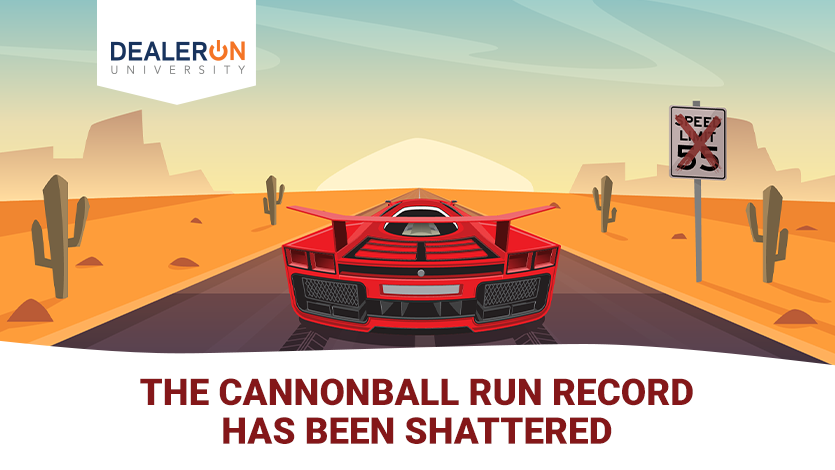

The Cannonball Run, an illegal street race immortalized in a pair of Burt Reynolds comedies from the early ’80s, has kept track of finishing times since its inception in 1971. During the present lockdown, the record has been absolutely demolished.
While the COVID pandemic has changed life in a number of terrible ways, and right now we all need some good news. Well, look no further. As anyone out there can attest, traffic is the lightest it’s been in, well, ever. A number of enterprising drivers have taken advantage of this fact to utterly annihilate a record that was long thought to be completely unbreakable.
That’s right, someone drove from New York to Los Angeles in 26 hours and 38 minutes.
Most people who are familiar with the Cannonball Run probably know it from a couple Burt Reynolds movies, released in the early ‘80s back when a blockbuster could literally just be Burt Reynolds in a car. The name is in fact a shortened version of the official illegal street race (as official as an illegal street race can be anyway), the “Cannonball Baker Sea-to-Shining-Sea Memorial Trophy Dash.” Yeah, I can see how that might not fit on a poster.
The CBSTSSMTD lasted from 1971-1979 and came with the undeniable allure of “What if we just drove super-fast across the country in heavily-modded cars?” Invented because Car and Driver executive editor Brock Yates had a beef with the recently imposed federal 55mph speed limit, the race caught on among gearheads. There was no better way to prove the superiority of their vehicles, drivers, and, a favorite of all Silent Generation and Boomer dads, route-planning.
The starting line was the Red Ball Garage in Manhattan, and the finish line is the Portofino Inn in Redondo Beach, a small city surrounded on all sides by the sprawl of Los Angeles. As long as the start and end points are observed, the cars can technically go anywhere they want. The second ever winner, a 1971 Ferrari Daytona 365 GTB driven by Yates and “retired” racer Dan Gurney, drove 35 miles more than anyone else in the race. They won partly because they were in a professionally-driven Ferrari. Funny how that works.
The times in the early days are a relic of another age, usually hovering in the mid 30-hour range and featuring cruising speeds of a comparatively stately 80 miles per hour. The official record for the original race is 32 hours and 51 minutes. Later, unofficial versions—and it feels a little silly talking about unofficial versions of an illegal street race, but go with me—managed to shave that record down to a torrid 28 hours and 50 minutes. That was long thought unbeatable, but no one imagined a time when freeways would be, well, free.
The modern incarnation of the race, thankfully going under the easier-to-type “Cannonball Run,” is semi-official, featuring a staggering amount of bad blood that would require an entire blog series to unpack. Suffice to say, anyone attempting a shot at the record has to abide by the rules: it’s all in a single stretch, your drivers and crew are all in the car, and any stops—whether it’s for gas or the bathroom—are counted against your time. It’s like those horror stories about road trips with schedule-obsessed dads, only with the additional wrinkle of avoiding local law enforcement.
The vehicles used in the race have run the gamut, from a heavily modified Dodge Custom Sportsman van—with the amazing sobriquet of Moon Trash II—way back in 1971 to an Audi A8 for the recent record-breaking run. The one thing they all have in common, though, are the mods. No one is driving anything off the assembly line. These are the kinds of vehicles that you’d find in a Fast and Furious movie.
One of the first modifications that any racer will make is pretty obvious: extra fuel tanks. When stopping for gas can be the difference between setting a record and being an also-ran, it just makes good sense. In addition, cars will utilize a variety of techniques to spot highway patrol, including stabilized thermal cameras, police scanners, and even laser jammers. Getting thrown in jail is one of the worst things that can happen to your time.
While the actual speeds are unknown, in order to complete the approximately 2800 mile course in the time announced, the winner’s average speed had to be around 107 mph. This of course, assumes there were no breaks for gas or bathrooms, which there had to be. It’s safe to assume that they violated the second all-time winner Gurney’s quote, “At no time did we exceed 175 miles per hour.” The only question is if they ever hit warp speed.
Despite the preternatural time of the winner, it’s safe to say that this won’t be the last attempt on the record in the coming days. Keep an eye on this space for any updates on this story or subsequent wins.
When the world undergoes a sudden upheaval, as it is now, there’s a natural tendency to retreat into comfort and safety. These racers instead went after a record at a unique time and place to not just break but shatter it. DealerOn is the same way; we’ve just released one of our biggest product ever with Symphony, something that will completely change the way you manage your website specials. And we’re not done either. We’re going to keep doing everything we can to help our dealers through this time and far off into the future. Call that our personal Cannonball Run.
Source: https://www.whichcar.com.au/news/the-cannonball-run-record-has-been-obliterated
Source: https://www.whichcar.com.au/news/americas-illegal-cannonball-record-broken
Source: https://adventure.howstuffworks.com/cannonball-run.htm


